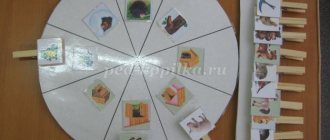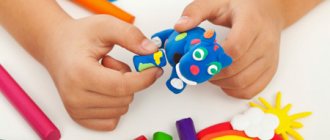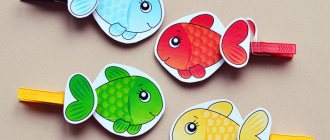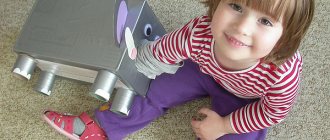Development of fine motor skills in children
Exercises after 3 years
Beads and cereals
This category includes games with small objects. It can be anything - beads, beads, various cereals, etc.
You can start with larger items. For example, large beads that a child will play with great interest in his hands.
Another option is cereals. Pour buckwheat or other cereal into a bowl and give it to your baby. He will touch it, roll it in his fingers. In this way, children develop tactile sensations and fine motor skills well.
You can add some kind of goal to these activities. For example, pour buckwheat onto the table and ask your child to separate the black grains from normal buckwheat. You can also ask him to sort the beads by color.
Screwing and unscrewing lids
Developing fine motor skills by screwing or unscrewing bottle caps (it’s better to choose different sizes) is a good exercise for developing dexterity in children’s fingers.
A similar effect is achieved by unfastening and fastening zippers and buttons. In addition, this way the child quickly learns to be independent. You can gradually develop in your child the understanding that he must button his own jacket, lace his shoes, etc.
Modeling
It is suitable for children of different ages. You can use different materials - plastic dough, plasticine, clay. Try to add variety to your classes every time. For example, if at first you just give your child plasticine, and he tries to mold something out of it, then later you can add some objects to the lessons and tell your child to stick plasticine around them. Handprints and various objects can be made from clay.
Parents can be advised to take their child with them to the kitchen when you want to bake something. Let your baby work with the dough, knead it with his hands, but be careful and remove all sharp objects.
Sand games
There are many different variations possible here. The child can draw with his finger in the sand, you can hide some objects and ask the child to find them in the sand. Such activities are only suitable for children over 3 years old, because young children put everything in their mouth.
Drawing, cutting, puzzles, construction sets
Cutting out figures and various objects from paper has an extremely beneficial effect on the development of fine motor skills. Here you need to start with something simple (cutting out shapes with straight lines) and move on to something more complex (cutting out shapes with curved lines, snowflakes, etc.). Carving is also useful because it develops spatial perception.
The same goes for drawing. At first, you can simply give your child a felt-tip pen and full scope for creativity. Then ask him to complete the missing part of the drawing, draw a line along the contours, etc.
Construction sets and puzzles not only develop fine motor skills, but also have a beneficial effect on a child’s imagination, memory and creativity. In addition, the baby develops patience and perseverance. There are a large number of options on sale for children of different ages.
DEFINITION
Fine motor skills are a set of movements performed by the fingers and hands. It is extremely important to develop it for several reasons.
- Through such activities, the internal organs of the baby are affected. Exercise has a beneficial effect on brain development.
- The ability to perform movements with fingers and hands is most often an indicator that the child is fully developing.
- Finger movements are directly related to speech centers in the cerebral cortex, so experts recommend training your hands in parallel with speech development. Moreover, doing motor skills exercises will help those children who suffer from speech impediments begin to speak better.
Work on fine motor skills should begin from a very early age. Even babies have their fingers massaged, but older children need to learn to perform basic actions on their own. This will be helped by special play exercises that are interesting and useful for kids.
SAFETY
To ensure that games aimed at developing fine motor skills do not cause harm to the baby, parents should follow the following rules.
- After the lesson, carefully remove all small objects so that a curious child, having discovered a familiar “entertainment”, does not accidentally swallow it or stick it in his nose or ear.
- During the training, the baby must be supervised. It is important for an adult to control literally every movement, because the child does not yet understand that he can harm himself.
These simple rules will help you avoid accidents.
The development of fine motor skills with the help of didactic games and exercises should become a habit for both parents and children. It is necessary to train with your child every day, coming up with new stories and using a variety of available means.
BENEFITS OF EXERCISE
Games and exercises that develop fine motor skills should be carried out with the child on a regular basis, as they not only improve the baby’s ability to work with his fingers and hand, but also stimulate speech development.
Without such activities, there is a risk that the child will be unprepared for school, his hand will not be able to hold a pen or write correctly. And the child himself may find himself helpless and experience difficulties in performing such basic actions as tying shoelaces.
Daily exercise will help improve attention and memory. Gaming technologies are diverse, so any parent can choose exercises to their liking.
FIRST CLASSES WITH SUBJECTS
Having learned the basic games with fingers, you can move on to the next step - practicing with objects. For the little ones, such developmental exercises will be useful.
- Working with a pencil and small hair ties. The parent holds a pencil in his hand. The child’s task is to put several small rubber bands on him one after another.
- Drawing with semolina. The parent pours a thin layer of cereal onto a flat plate or cutting board, inviting the baby to run his finger over it. You will get a line. In the same way, the child draws several stripes on the semolina.
- Laying out the beans. The mother gives the baby a small handful of beans (beads or buttons can replace them). The preschooler is required to lay it out on the table in piles or make a path.
- Working with beads, stringing large elements. They can be replaced with pasta pre-dyed in different colors.
- Working with buttons. The parent draws a circle on a piece of paper. The child is given instructions to arrange buttons, paper clips, and beans along its contour.
- Children love to imitate adults, and this should be used in organizing classes. So, the mother can invite the baby to stir the sugar in his tea himself.
- "Firework". The baby’s task is to tear a sheet of paper into as small pieces as possible and fold them on the table. Then these scraps are held in the hands and tossed, like a real fireworks display.
The main rule is to practice every day, but do not force the baby. Training should bring joy, not irritation.
RULES FOR PERFORMING FINGER EXERCISES
Working with the baby on the development of fine motor skills should be carried out on a regular basis, but not tire the child. The easiest way to do it is with finger games, which perfectly stimulate the brain and help develop dexterity, attention, and memory. The work is carried out first with the right hand, then with the left. An adult is required to monitor the correct execution of the movements, so before showing them to a child, you need to practice yourself.
Advice
You should start with 2-3 repetitions of each exercise, gradually increasing them to 5-8. Training is carried out daily, and a few minutes a day is enough.
Didactic manuals advise: if the child gets tired, the lesson can be broken up. Do the first two exercises in the morning, two more in the afternoon, and one in the late afternoon.
AGE
Pediatricians recommend starting conscious daily training with a child who is 4-5 years old. But at an earlier age, fingers need to be given attention - massage, kneading active points that are directly connected to the brain centers.
So, for the youngest (up to 2 years old) the following exercises can be used:
- stroking the palm;
- flexion-extension of fingers;
- clapping your hands.
To make the child have fun, the lesson should be accompanied by reading nursery rhymes about the White-sided Magpie and playing “Ladushki”.
If a child attends kindergarten, then teachers in the younger group conduct classes on the development of fine motor skills, but for parents this is not a reason to refuse home training, which will help consolidate the acquired skills and translate them into skills. Therefore, on weekends you need to work with your baby using a playful form, offering him new interesting tasks.
MOST POPULAR GAMES
The game catalog contains a huge number of options. We offer some simple finger games that are loved by most children.
- Squeeze all the fingers on both hands, then unclench them. Run several times.
- Squeeze the fingers on your right hand and unclench them one by one. Repeat the exercise with the left.
To make it interesting for the child, during the lesson the parent can read funny poems to him or write a story about how a fairy-tale character (a bear) got home with the help of finger movements. For example: the bear passed the first forest - extend one finger. The bear passed the second forest - we unbend the second one. The child will try to do the exercise to find out how the fairy tale ends.
- "Fan". The exercise is useful for the fingers; it is performed like this: press your fingers together (imitating a closed fan), then spread them as wide as possible (the fan has opened), and wave your hand.
- A very good exercise that helps develop not only motor skills, but also attention and reaction speed - “Scratch-scratch”. The parent places his hand on the table, the baby places his palm on the adult’s palm and listens to him. Mom or dad tells a poem or a fairy tale, the child’s task is to be attentive. As soon as “tsap-scratch” is heard (this can be any other phrase discussed in advance), he needs to remove his palm as quickly as possible, otherwise the parent will cover it with his other hand. After a few practices, parent and baby can switch roles.
- "Butterfly". First, the fingers are clenched into a fist, now you need to straighten the little finger one at a time, then the ring and middle fingers. Create a ring from the index finger and thumb. The butterfly is ready. Now you need to ask the child to “flap his wings” - make movements with straight fingers.
If one of the finger games causes difficulty, you can replace it with another for a while; you should not torment your child with a mandatory mindset for success.
WE MAKE EXERCISES
To teach a child to use a brush and make movements with his fingers, parents will have to try and be patient, because not everything will work out the first time. To prevent your baby from losing interest, it is important to offer him a variety of exercises. Therefore, moms and dads will have to create exercise equipment with their own hands. There are many options.
The bird is made like this:
- take a cardboard box (for example, pizza, candy).
- an image of a bird is applied to it, preferably large in size (the bird can be pasted on or drawn);
- A hole is made in the cardboard near the beak.
The baby’s task is to lower one grain into the hole (to feed the bird).
In a similar way, you can feed the worm peas.
A simulator with bands can be done like this:
- several satin ribbons are attached to a vertical surface (you can sew them to a special rug, which you hang on the wall so that the baby can easily reach it);
- A small wooden stick is glued to the other side of each ribbon (you can use a popsicle stick).
The child’s task is to try to twist the ribbon.
Children are also very fond of homemade lacing, exercises with which contribute to the formation of a very important skill - lacing shoes.
You can make an interesting activity yourself from felt - cut out a hedgehog figurine and fruit, inviting your child to place the “prey” on the hedgehog’s spines.
You can purchase special educational toys in the store - construction sets, mosaics, puzzles, pyramids, and a magic basket.
BASIC GAMES
Parents should prepare in advance a set of games that will help their 4-5 year old child develop the ability to work with fingers and perform small movements. There are a great variety of similar exercises; almost all the tools can be created from improvised means.
You can offer the following options for exciting games.
- With cereals and large objects (for example, a button, a bead). The parent takes a deep bowl, fills it with cereal, into which he buries several buttons. The baby’s task is to find and get them.
Advice
For this exercise, you can use almost any cereal: rice, peas, buckwheat.
- Untying knots. You need to start with simple ones, using a thick rope, gradually complicating the task.
- Labyrinth. An adult draws a “labyrinth” on a piece of paper, and the child’s task is to walk through it with the index and middle fingers, imitating steps.
These exercises develop the hand and fingers well.








